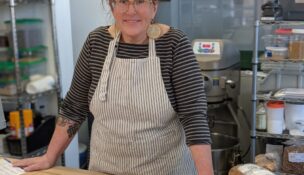

Carbondale’s creative secret sauce
Neil McKenzie //September 19, 2012//
I have embarked on a project to visit the State’s many arts and creative districts to see what they are doing to promote the creative economy. The first stop on my tour was the town of Carbondale, a town with a population of about 6,500 located in the Roaring Fork Valley between Glenwood Springs and Aspen.
The town of Carbondale was incorporated in 1888 when the economy was largely based on agriculture to supply food to the booming mining town of Aspen – each September for the last 102 years they have hosted the annual Potato Day Parade and Celebration. While the Carbondale economy still has its agricultural and ranching roots, the town now relies heavily on tourism, supporting the valley’s growing population with its small businesses – and the arts.
Building the arts
In 2012, Carbondale was awarded the Governor’s Arts Award along with the city of Lafayette.
“The communities being honored by this award have each made a major commitment to the arts and creativity,” Gov. John Hickenlooper said. “They have invested in arts centers and downtown arts districts. They have made sure their young people continue to have access to the arts in school, and they have encouraged their citizens and their businesses to support local artists and arts organizations.”
The arts are not new to Carbondale, and the growth of this sector has been a long path, one not without its ups and downs. In the late 1960s, the town began to attract a young and creative population which the locals like to refer to as “hippies”. Today many of these same people are still involved in shaping the town’s creative economy. This year’s 41st Mountain Fair serves an example of the influence of creative pioneers.
At first glance, Carbondale might appear to be your basic western Colorado rural community. But turn down Main Street, and you will see why the town won the Governor’s Arts Award. They have developed what many arts districts and urban development professionals like to call a “sense of place”.
On Carbondale’s Main Street, you won’t find the scene that faces many small towns where the once vibrant downtown area is deserted and businesses have moved out the edge to modern real estate developments – although the town has these as well. What you will find is a busy downtown area composed mostly of older building along with some newer ones that fit the character of the town.
One of the things you will first notice in the downtown area is that you feel comfortable. The area is vibrant with friendly people, shops, places to eat, entertainment venues and of course, art. Carbondale is home to more than 40 pieces of public art, the Carbondale Council on Arts and Humanities and more than a dozen art galleries and artist’s studios. Carbondale has more than just a sense of place; it’s an experience.
How did they do it?
Carbondale’s creative sector is a work in progress, one that started many years ago when a community of hippies decided to make it their home. The town’s success in building a vibrant creative sector and creating a great experience is due to a number of factors:
- Artists like Marcel Kahhak who has resided in Carbondale for more than 14 years and has built an international following for his work. On a warm evening you will likely find him teaching others to paint in his Kahhak Fine Arts & School or possibly playing a game of chess out in front as he chats with people passing by.
- The work of the Carbondale Council on Arts and Humanities founded by the original group of hippies that provides classes for the community, sponsors the Carbondale Mountain Fair, the Green Is the New Black Fashion Extravaganza among many other community events and programs.
- The Carbondale Chamber of Commerce who helps market the town’s First Friday Art Walks and whose members support the local creative economy.
- A great selection of restaurants and cafes that offer a wide range and variety of food and dining experiences.
- Entertainment venues where you might experience everything from a dance performance to a jazz band from New Orleans performing live.
- Shops and stores that offer a local flavor of goods and services
- A diverse community that appreciates and participates in the creative sector.
Their “Secret Sauce”
Communities all over that country are working to put together a formula that will revitalize their areas and take advantage of all that the creative economy has to offer. Many are struggling. As I walked the streets of Carbondale, I could not help notice a sign promoting their First Friday Art Walk. It had four simple words, Art, Shop, Eat, Music.
Carbondale seems to have found the right ingredients for a successful arts/creative district. To use a baking analogy, it takes more than just ingredients to make a great cake. It takes the right ingredients in the right amounts coupled with experience and skill – Carbondale’s recipe is no different. It has taken a community of passionate creative people with staying power to weather the ups and downs. It has taken support from its diverse community and support from business and government alike.
The town also faces challenges in leveraging their creative sector’s success while keeping their creative identity in the face of ever increasing growth. One challenge is to attract other creative businesses such as architects, designers and software development that will benefit from the existing creative infrastructure. Another challenge is to guide the town’s growth in a manner that moves it ahead in the 21st century while keeping its sense of place.
Carbondale can be a model for other Colorado areas developing their own creative districts and initiatives. The recipe for their secret sauce can be a great starting point along with a dash of local flavor.
























